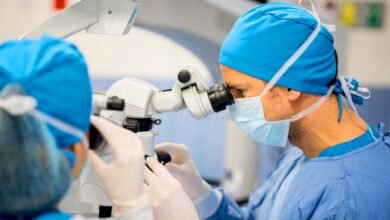The Benefits of Using Augmented Reality for Medical Education and Training

In today’s rapidly evolving world, technology plays an increasingly significant role in various sectors, and medical education and training are no exception. Augmented Reality (AR) has emerged as a groundbreaking technology that has the potential to revolutionize how medical professionals are educated and trained. This article explores the advantages of incorporating augmented Reality into medical education and training programs.
Augmented Reality for Medical Education
Medical education and training traditionally rely on textbooks, cadavers, and limited hands-on experiences. However, integrating augmented reality technology into medical training programs changes the game. AR combines digital elements with the real world, providing a dynamic and interactive learning environment.
Understanding Augmented Reality
Augmented Reality for Medical Education: Augmented Reality, often abbreviated as AR, is a cutting-edge technology that blends the digital world with the real world. It overlaps computer-generated content, such as images, videos, and 3D models, onto the user’s surroundings. This amalgamation of the virtual and the real creates an immersive and interactive experience.
Here’s a breakdown of key components and concepts related to Augmented Reality:
- Real-World Integration: Unlike Virtual Reality (VR), where users are completely immersed in a digital environment, AR supplements the real world. It enhances our perception of Reality rather than replacing it.
- User Perspective: AR is typically experienced through devices like smartphones, tablets, smart glasses, or headsets. These devices use cameras to capture the real world and display augmented content on their screens.
- Marker-Based and Markerless AR: AR applications can use markers (visual cues) in the physical world to trigger augmented content. Markerless AR relies on object recognition and tracking without predefined markers.
- Interactive Elements: AR allows users to interact with the digital elements overlaid in the real world. This interaction can include touching, moving, or manipulating virtual objects.
- Applications Across Industries: Augmented Reality finds applications in various sectors, including gaming, education, healthcare, architecture, marketing, and manufacturing. It enhances experiences and provides valuable information in these fields.
- Enhanced Visualization: AR can be used to visualize complex concepts in educational contexts. For example, in medical education, students can explore 3D models of organs or practice surgical procedures on virtual patients.
- Navigation and Information: AR is commonly used for navigation and location-based services. Apps like Google Maps use AR to display directions and points of interest in the real world.
- Entertainment and Gaming: Augmented Reality has gained popularity in the gaming industry, with games like Pokémon GO allowing players to interact with virtual creatures in the real world.
- Training and Simulation: It’s widely used in training simulations, such as flight training for pilots or military personnel. AR allows trainees to practice in a safe and controlled environment.
- Future Potential: AR is expected to become even more prevalent and sophisticated as technology advances. It may be pivotal in telemedicine, remote collaboration, and immersive storytelling.
Augmented Reality enriches our perception of Reality by adding digital layers to our physical environment. Its potential is vast, and its applications continue to evolve, making it an exciting and transformative technology in today’s digital age.
Read More: Ranking the Top Medical Colleges: A Comprehensive Guide
Enhanced Learning Experience
Augmented Reality for Medical Education: One of the primary benefits of AR in medical education is the enhanced learning experience it offers. Students can visualize complex anatomical structures in 3D, making it easier to understand and remember. This hands-on approach fosters deeper comprehension and retention of knowledge.
Realistic Simulations
Augmented Reality for Medical Education: AR allows medical students to use realistic medical simulations. For example, they can practice surgical procedures on virtual patients, learning from their mistakes without risk to real patients. This not only improves their skills but also boosts their confidence.
Improving Diagnostic Skills
Augmented Reality for Medical Education: AR can simulate various medical conditions, helping students develop their diagnostic skills. By examining virtual patients with different symptoms, students can hone their ability to identify diseases and recommend appropriate treatments.
Remote Learning Opportunities
Augmented Reality for Medical Education: The COVID-19 pandemic highlighted the importance of remote learning. AR enables students to participate in medical education programs from anywhere, reducing the need for physical presence in classrooms or labs. This flexibility is especially valuable in times of crisis.
Cost-Effective Training
Augmented Reality for Medical Education: Traditional medical training methods can be costly due to the need for physical resources and equipment. AR reduces these expenses by providing virtual alternatives. Institutions can allocate their budgets more efficiently, making education more accessible.
Customized Learning Paths
Augmented Reality for Medical Education: AR systems can adapt to individual learning styles and paces. Students can progress through modules at their own speed, ensuring that they fully grasp each concept before moving on. This personalized approach enhances the learning process.
Enhancing Surgical Training
Enhancing Surgical Training with Augmented Reality (AR):
Surgical training is critical to medical education, where precision and hands-on experience are paramount. Augmented Reality (AR) technology has emerged as a groundbreaking tool for improving surgical training in numerous ways:
- Realistic Simulations: AR enables aspiring surgeons to practice and refine their skills through realistic surgical simulations. These simulations can mimic various surgical procedures, offering a safe and controlled environment for learning.
- Immersive Learning: AR creates an immersive learning experience by overlaying digital surgical elements in the real-world environment. Trainees can interact with 3D models of organs, surgical instruments, and patient scenarios, providing a lifelike experience.
- Repetition without Risk: One of the primary advantages of AR-based surgical training is the ability to repeat procedures as often as needed without any risk to actual patients. This repetition helps surgeons build confidence and muscle memory.
- Guided Procedures: AR can provide step-by-step guidance during surgical procedures. Surgeons can view important information and instructions directly in their field of vision, reducing the need to look away from the surgical area.
- Remote Mentoring: AR technology allows for remote mentoring and collaboration. Experienced surgeons can guide trainees during procedures from different locations, sharing their expertise in real-time.
- Objective Feedback: AR systems can provide objective feedback on surgical performance. Trainees can receive precision, speed, and accuracy metrics, allowing for targeted improvement.
- Reducing Anxiety: Surgical training with AR can help reduce anxiety among trainees. Familiarity with the procedure and the environment before surgery can lead to better outcomes and less stress.
- Customized Learning Paths: AR platforms can adapt to individual learning styles and paces. Trainees can progress through modules quickly, ensuring a comprehensive understanding of each surgical technique.
- Surgical Planning: AR can assist in planning by allowing surgeons to visualize the patient’s anatomy in 3D before the operation. This helps in identifying potential challenges and optimizing the surgical approach.
- Continual Learning: Even experienced surgeons can benefit from AR-assisted training. It provides opportunities for continual learning and staying updated on the latest surgical techniques and technologies.
Boosting Student Engagement
Augmented Reality for Medical Education: Traditional lectures can sometimes be passive and less engaging. AR makes learning interactive and exciting. Students actively participate in lessons, making the educational journey more enjoyable and effective.
Measuring Student Progress
Augmented Reality for Medical Education: AR platforms can track and analyze student performance. Instructors can identify areas where students may be struggling and provide targeted support, ultimately leading to better learning outcomes.
Accessibility and Inclusivity
Augmented Reality for Medical Education: AR technology can cater to diverse learning needs. It can accommodate students with disabilities, making education more inclusive. Visual and auditory aids can be customized to suit individual requirements.
Challenges and Limitations
Augmented Reality for Medical Education: While AR offers immense potential, it also presents challenges such as the cost of implementation, technical issues, and the need for training instructors to use the technology effectively. Overcoming these hurdles will be crucial for widespread adoption.
Future of AR in Medical Education
Augmented Reality for Medical Education: The future of medical education and training undoubtedly includes augmented Reality. AR systems will become more sophisticated, affordable, and integrated into curricula worldwide as technology advances.
Read More: Ranking the Top Medical Colleges: A Comprehensive Guide
Conclusion
In an era of rapid technological advancements, integrating Augmented Reality (AR) into medical education and training has emerged as a transformative force. The benefits of harnessing this cutting-edge technology are multifaceted and profound.
AR has ushered in a new era of enhanced learning experiences. It enables students and aspiring medical professionals to engage with complex anatomical structures, medical procedures, and patient scenarios in a once inconceivable way. This hands-on, immersive approach fosters deeper understanding, improved knowledge retention, and greater confidence.
Moreover, AR’s ability to provide realistic simulations has revolutionized medical training. It offers a safe space for trainees to practice surgical procedures, make mistakes, and learn from them—without risk to real patients. This not only hones their skills but also instills invaluable competence in the field.
FAQs
1. Is augmented Reality only for medical students, or can practicing physicians benefit from it, too?
Augmented Reality is beneficial for both medical students and practicing physicians. It can be used for ongoing medical education and to enhance surgical skills.
2. How does augmented reality technology help in remote learning?
Augmented Reality allows students to access virtual learning experiences from anywhere, allowing education to continue during crises like the COVID-19 pandemic.
3. Are there any cost-effective options for implementing AR in medical education?
As technology advances, the cost of implementing augmented Reality in medical education is expected to decrease, making it more accessible to institutions with limited budgets.
4. Can AR be used in specialties other than surgery?
AR can be applied to various medical specialties, including radiology, internal medicine, and pediatrics, to enhance education and training.
5. What steps can institutions take to address the challenges of implementing AR in medical education?
Institutions should invest in training for instructors, collaborate with technology providers, and gradually integrate AR into their curricula to address challenges effectively.







